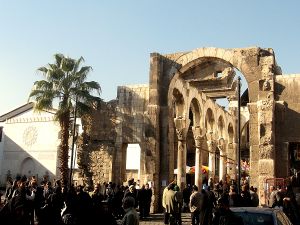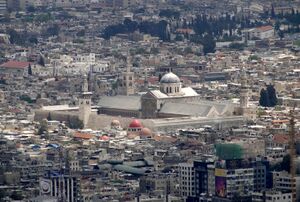تاريخ دمشق
تاريخ دمشق.
. . . . . . . . . . . . . . . . . . . . . . . . . . . . . . . . . . . . . . . . . . . . . . . . . . . . . . . . . . . . . . . . . . . . . . . . . . . . . . . . . . . . . . . . . . . . . . . . . . . . . . . . . . . . . . . . . . . . . . . . . . . . . . . . . . . . . . . . . . . . . . . . . . . . . . . . . . . . . . . . . . . . . . . .
الاستيطان المبكر
Carbon-14 dating at Tell Ramad, on the outskirts of Damascus, suggests that the site may have been occupied since the second half of the seventh millennium BC, possibly around 6300 BC.[1] However, evidence of settlement in the wider Barada basin dating back to 9000 BC exists, although no large-scale settlement was present within Damascus' walls until the second millennium BC.[2]
Some of the earliest Egyptian records are from the 1350 BC Amarna letters, when Damascus (called Dimasqu) was ruled by king Biryawaza. The Damascus region, as well as the rest of Syria, became a battleground circa 1260 BC, between the Hittites from the north and the Egyptians from the south,[3] ending with a signed treaty between Hattusili and Ramesses II where the former handed over control of the Damascus area to Ramesses II in 1259 BC.[3] The arrival of the Sea Peoples, around 1200 BC, marked the end of the Bronze Age in the region and brought about new development of warfare.[4] Damascus was only a peripheral part of this picture, which mostly affected the larger population centers of ancient Syria. However, these events contributed to the development of Damascus as a new influential center that emerged with the transition from the Bronze Age to the Iron Age.[4]
Damascus is mentioned in Genesis 14:15 as existing at the time of the War of the Kings.[5] According to the 1st-century Jewish historian Flavius Josephus in his twenty-one volume Antiquities of the Jews, Damascus (along with Trachonitis), was founded by Uz, the son of Aram.[6] In Antiquities i. 7,[7] Josephus reports:
Nicolaus of Damascus, in the fourth book of his History, says thus: "Abraham reigned at Damascus, being a foreigner, who came with an army out of the land above Babylon, called the land of the Chaldeans: but, after a long time, he got him up, and removed from that country also, with his people, and went into the land then called the land of Canaan, but now the land of Judea, and this when his posterity were become a multitude; as to which posterity of his, we relate their history in another work. Now the name of Abraham is even still famous in the country of Damascus; and there is shown a village named from him, The Habitation of Abraham.
آرام-دمشق
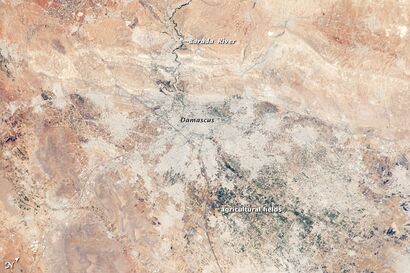
Damascus is first documented as an important city during the arrival of the Aramaeans, a Semitic people, in the 11th century BC. By the start of the first millennium BC, several Aramaic kingdoms were formed, as Aramaeans abandoned their nomadic lifestyle and formed federated tribal states. One of these kingdoms was Aram-Damascus, centered on its capital Damascus.[9] The Aramaeans who entered the city without battle, adopted the name "Dimashqu" for their new home. Noticing the agricultural potential of the still-undeveloped and sparsely populated area,[10] they established the water distribution system of Damascus by constructing canals and tunnels which maximized the efficiency of the river Barada. The same network was later improved by the Romans and the Umayyads, and still forms the basis of the water system of the old part of the city today.[11] The Aramaeans initially turned Damascus into an outpost of a loose federation of Aramaean tribes, known as Aram-Zobah, based in the Beqaa Valley.[10]
The city would gain pre-eminence in southern Syria when Ezron, the claimant to Aram-Zobah's throne who was denied kingship of the federation, fled Beqaa and captured Damascus by force in 965 BC. Ezron overthrew the city's tribal governor and founded the independent entity of Aram-Damascus. As this new state expanded south, it prevented the Kingdom of Israel from spreading north and the two kingdoms soon clashed as they both sought to dominate trading hegemony in the east.[10] Under Ezron's grandson, Ben-Hadad I (880–841 BC), and his successor Hazael, Damascus annexed Bashan (modern-day Hauran region), and went on the offensive with Israel. This conflict continued until the early 8th century BC when Ben-Hadad II was captured by Israel after unsuccessfully besieging Samaria. As a result, he granted Israel trading rights in Damascus.[12]
Another possible reason for the treaty between Aram-Damascus and Israel was the common threat of the Neo-Assyrian Empire which was attempting to expand into the Mediterranean coast. In 853 BC, King Hadadezer of Damascus led a Levantine coalition, that included forces from the northern Aram-Hamath kingdom and troops supplied by King Ahab of Israel, in the Battle of Qarqar against the Neo-Assyrian army. Aram-Damascus came out victorious, temporarily preventing the Assyrians from encroaching into Syria. However, after Hadadzezer was killed by his successor, Hazael, the Levantine alliance collapsed. Aram-Damascus attempted to invade Israel, but was interrupted by the renewed Assyrian invasion. Hazael ordered a retreat to the walled part of Damascus while the Assyrians plundered the remainder of the kingdom. Unable to enter the city, they declared their supremacy in the Hauran and Beqa'a valleys.[12]
By the 8th century BC, Damascus was practically engulfed by the Assyrians and entered a Dark Age. Nonetheless, it remained the economic and cultural center of the Near East as well as the Arameaen resistance. In 727, a revolt took place in the city, but was put down by Assyrian forces. After Assyria led by Tiglath-Pileser III went on a wide-scale campaign of quelling revolts throughout Syria, Damascus became totally subjugated by their rule. A positive effect of this was stability for the city and benefits from the spice and incense trade with Arabia. In 694 BC, the town was called Šaʾimerišu (Akkadian: 𒐼𒄿𒈨𒊑𒋙𒌋) and its governor was named Ilu-issīya.[13] However, Assyrian authority was dwindling by 609–605 BC, and Syria-Palestine was falling into the orbit of Pharaoh Necho II's Egypt. In 572 BC, all of Syria had been conquered by Nebuchadnezzar II of the Neo-Babylonians, but the status of Damascus under Babylon is relatively unknown.[14]
الفترة اليونانية-الرومانية
Damascus was conquered by Alexander the Great. After the death of Alexander in 323 BC, Damascus became the site of a struggle between the Seleucid and Ptolemaic empires. The control of the city passed frequently from one empire to the other. Seleucus I Nicator, one of Alexander's generals, made Antioch the capital of his vast empire, which led to the decline of Damascus' importance compared with new Seleucid cities such as Latakia in the north. Later, Demetrius III Philopator rebuilt the city according to the Greek hippodamian system and renamed it "Demetrias".[15]
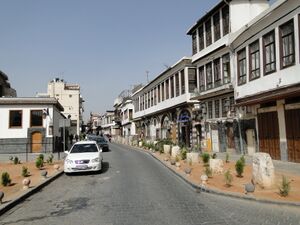
In 64 BC, the Roman general Pompey annexed the western part of Syria. The Romans occupied Damascus and subsequently incorporated it into the league of ten cities known as the Decapolis[16] which themselves were incorporated into the province of Syria and granted autonomy.[17]
The city of Damascus was entirely redesigned by the Romans after Pompey conquered the region. Still today the Old Town of Damascus retains the rectangular shape of the Roman city, with its two main axes: the Decumanus Maximus (east-west; known today as the Via Recta) and the Cardo (north-south), the Decumanus being about twice as long. The Romans built a monumental gate which still survives at the eastern end of Decumanus Maximus. The gate originally had three arches: the central arch was for chariots while the side arches were for pedestrians.[18]
In 23 BC, Herod the Great was given lands controlled by Zenodorus by Caesar Augustus[19] and some scholars believe that Herod was also granted control of Damascus as well.[20] The control of Damascus reverted to Syria either upon the death of Herod the Great or was part of the lands given to Herod Philip which were given to Syria with his death in 33/34 AD.
It is speculated that control of Damascus was gained by Aretas IV Philopatris of Nabatea between the death of Herod Philip in 33/34 AD and the death of Aretas in 40 AD but there is substantial evidence against Aretas controlling the city before 37 AD and many reasons why it could not have been a gift from Caligula between 37 and 40 AD.[21][22] In fact, all these theories stem not from any actual evidence outside the New Testament but rather "a certain understanding of 2 Corinthians 11:32" and in reality "neither from archaeological evidence, secular-historical sources, nor New Testament texts can Nabatean sovereignty over Damascus in the first century AD be proven."[23] Roman emperor Trajan who annexed the Nabataean Kingdom, creating the province of Arabia Petraea, had previously been in Damascus, as his father Marcus Ulpius Traianus served as governor of Syria from 73 to 74 AD, where he met the Nabatean architect and engineer, Apollodorus of Damascus, who joined him in Rome when he was a consul in 91 AD, and later built several monuments during the 2nd century AD.[24]
Damascus became a metropolis by the beginning of the 2nd century and in 222 it was upgraded to a colonia by the Emperor Septimius Severus. During the Pax Romana, Damascus and the Roman province of Syria in general began to prosper. Damascus's importance as a caravan city was evident with the trade routes from southern Arabia, Palmyra, Petra, and the silk routes from China all converging on it. The city satisfied the Roman demands for eastern luxuries. Circa 125 AD the Roman emperor Hadrian promoted the city of Damascus to "Metropolis of Coele-Syria".[25][26]
Little remains of the architecture of the Romans, but the town planning of the old city did have a lasting effect. The Roman architects brought together the Greek and Aramaean foundations of the city and fused them into a new layout measuring approximately 1,500 by 750 m (4,920 by 2,460 ft), surrounded by a city wall. The city wall contained seven gates, but only the eastern gate, Bab Sharqi, remains from the Roman period. Roman Damascus lies mostly at depths of up to five meters (16 feet) below the modern city.
The old borough of Bab Tuma was developed at the end of the Roman/Byzantine era by the local Eastern Orthodox community. According to the Acts of the Apostles, Saint Paul and Saint Thomas both lived in that neighborhood. Roman Catholic historians also consider Bab Tuma to be the birthplace of several Popes such as John V and Gregory III. Accordingly, there was a community of Jewish Christians who converted to Christianity with the advent of Saint Paul's proselytisation.
During the Byzantine–Sasanian War of 602–628, the city was besieged and captured by Shahrbaraz in 613, along with a large number of Byzantine troops as prisoners,[27] and was in Sasanian hands until near the end of the war.[28]
فترة الخلفاء الراشدين
Muhammad's first indirect interaction with the people of Damascus was when he sent a letter, through his companion Shiya ibn Wahab, to Harith ibn Abi Shamir, the king of Damascus. In his letter, Muhammad stated: "Peace be upon him who follows true guidance. Be informed that my religion shall prevail everywhere. You should accept Islam, and whatever under your command shall remain yours."[29][30]
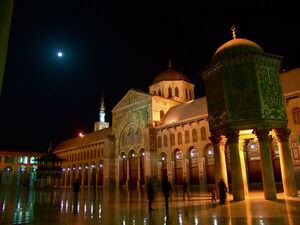
After most of the Syrian countryside was conquered by the Rashidun Caliphate during the reign of Caliph Umar (ح. 634–644), Damascus itself was conquered by the Arab Muslim general Khalid ibn al-Walid in August-September 634 CE. His army had previously attempted to capture the city in April 634, but without success.[31] With Damascus now in Muslim-Arab hands, the Byzantines, alarmed at the loss of their most prestigious city in the Near East, had decided to wrest back control of it. Under Emperor Heraclius, the Byzantines fielded an army superior to that of the Rashidun in manpower. They advanced into southern Syria during the spring of 636 and consequently Khalid ibn al-Walid's forces withdrew from Damascus to prepare for renewed confrontation.[32] In August, the two sides met along the Yarmouk River where they fought a major battle which ended in a decisive Muslim victory, solidifying Muslim rule in Syria and Palestine.[33] While the Muslims administered the city, the population of Damascus remained mostly Christian—Eastern Orthodox and Monophysite—with a growing community of Muslims from Mecca, Medina, and the Syrian Desert.[34] The governor assigned to the city which had been chosen as the capital of Islamic Syria was Mu'awiya I.
العصران الأموي والعباسي
لما اتسعت الدولة العربية نحو الشرق رؤى أن من مصلحتها أن تكون عاصمتها في موضع أقرب إلى وسطها من مكة أو بيت المقدس. وقد أحسن بنو أمية إذ اختاروا دمشق عاصمة لدولتهم-وكانت هذه المدينة ذات تاريخ قديم حين أقبل عليها العرب فاتحين. وكان يلتقي عندها خمسة أنهار، تجعل الإقليم الذي من خلفها "جنة الشرق" بحق، وتمد بالماء مائة فسقية، ومائة حمام عام، ومائة وعشرين ألف بستان(84)، ثم تجري نحو الغرب إلى "وادي البنفسج" الذي يبلغ طوله اثني عشر ميلاً وعرضه ثلاثة أميال. ويقول الإدريسي إن "مدينة دمشق من أجل بلاد الشام وأحسنها مكاناً، وأعدلها هواء، وأطيبها ثرى، وأكثرها مياهاً، وأغزرها فواكه، وأعمها خصاً، وأوفرها مالاً وأكثرها جنداً.[35]
وفي قلب هذه المدينة وبين سكانها الذين يبلغون نحو مائة وأربعين ألفاً يقوم قصر الخليفة الذي شاده معاوية الأول، والذي يلمع فيه الذهب والرخام، وتتلألأ في أرضه وعلى جدرانه الفسيفساء، والذي تلطف جوه الفساقي والشلالات التي يتدفق منها الماء على الدوام. وفي الناحية الشمالية من المدينة يقوم مسجدها العظيم وهو واحد من اثنين وسبعين وخمسمائة مسجد في المدينة، والأثر الوحيد الباقي من دمشق الأموية. وكان موضعه في أيام الروم يزدان بهيكل لجوبتر، ثم أقام ثيودوسيوس الأول على أنقاضه كنيسة يوحنا المعمدان (379). وعرض الخليفة الوليد الأول على المسيحيين حوالي عام 705 أن يعدل بناء الكنيسة حتى تصبح جزءاً من مسجد جديد يريد بناءه في ذلك المكان، ووعدهم بأن يعطيهم أرضاً ومواد في أي مكان يختارونه ليقيموا فيه كنيسة جديدة. ولكن المسيحيين احتجوا على هذا العمل وحذروه من عاقبته، وقالوا إنه قد ورد في كتبهم أن من يجرؤ على هدم الكنيسة سيموت مختنقاً؛ ولكن الوليد لم يأبه بهذا التحذير وكان هو البادئ بهد الكنيسة بيديه. ويقول المؤرخون أن جميع خراج الأرض في الدولة كلها قد خصص مدى سبع سنين لتشييد هذا المسجد، هذا إلى المال الكثير الذي أعطي للمسيحيين لينشئوا بهِ كنيسة جديدة. وجيء بالصناع والفنانين من الهند، وفارس، والقسطنطينية، ومصر، وليبيا، وتونس، والجزائر، وكان من استخدم في بنائه من العمال اثني عشر ألف عامل، أتموه في ثمان سنين. والرحالة المسلمون مجمعون على أنه أفخم بناء في بلاد المسلمين، ويرى المهدي والمأمون من الخلفاء العباسيين-وليس منهما من يحب الأمويين أو دمشق-أنه لا يضارعه بناء غيره في جميع أنحاء العالم. ويتكون البناء من سور محصن، في داخله صفوف من العمد تحيط بصحنه الواسع المرصوفة أرضه بالرخام. ويقوم المسجد نفسه في الجهة الغربية من هذا المكان المتسع، وهو مشيد من الكتل الحجرية المربعة وتشرف عليه أربع مآذن-منها واحدة هي أقدم ما شيد من المآذن في الإسلام. وكان تخطيط المسجد وزخرفته على الطراز الروماني، وما من شك في أنهما قد تأثرا بطراز صوفيا. وكان السقف والقبة_ ويبلغ طول قطرها خمسين قدماً-مكفتين بصفائح الرصاص. أما داخل المسجد الذي يبلغ طوله 429 قدماً فيشتمل على صفين من العمد المنحوتة من الرخام الأبيض تفصل صحنه عما يحيط به من الطرقات. وتيجان هذه العمد كورنشية الطراز مكفتة بصفائح الذهب. ومن فوقها عقود مستديرة أو على شكل حذاء الفرس.
وهذا الطراز الثاني من العقود أول ما اقيم من نوعه في بلاد الإسلام . وأرض المسجد من الفسيفساء وقد غطيت بالطنافس، كما غطيت جدرانه بالفسيفساء المصنوعة من الرخام الملون وبالقاشاني المطعم بالميناء، وفي داخل المسجد ستة حواجز جميلة من الرخام تقسم داخله إلى عدة إيونات. وفي أحد جدرانه المتجهة نحو مكة محراب مرصع بالذهب والفضة والحجارة الكريمة، ويدخل الضوء إلى المسجد من أربعة وسبعين شباكاً من الزجاج الملون ومن اثني عشر ألف قنديل. ويصفه أحد الرحالة بقولهِ: "لو أن رجلاً من أهل الحكمة اختلف إليه سنة لأفاد منه كل يوم صفة وعقدة أخرى" .
وسمح لأحد سفراء اليونان أن يدخل المسجد فلما شاهده التفت إلى رفاقه وقال لهم: "لقد قلت لأعضاء مجلس الشيوخ في بلادي إن سلطان العرب سيزول عما قريب، أما الآن وأنا أرى كيف كانوا يشيدون عمائرهم فقد علمت علم اليقين أن سلطانهم سيدوم أحقاباً طوالاً" .
. . . . . . . . . . . . . . . . . . . . . . . . . . . . . . . . . . . . . . . . . . . . . . . . . . . . . . . . . . . . . . . . . . . . . . . . . . . . . . . . . . . . . . . . . . . . . . . . . . . . . . . . . . . . . . . . . . . . . . . . . . . . . . . . . . . . . . . . . . . . . . . . . . . . . . . . . . . . . . . . . . . . . . . .
الحروب الصليبية
في ٢٨ تشرين الأول ١١٧٤، دخل صلاح الدين الأيوبي دمشق فاتحاً ليضم بذلك بلاد الشام إلى دولته. كان صلاح الدين قد بنى دولة قوية في مصر وعزم على توحيد الديار العربية للتصدي للصليبيين. وبعد وفاة السلطان نور الدين محمود، أرسل أمير دمشق إلى صلاح الدين طالباً دعمه أمام أطماع سعد الدين كمشتكين صاحب حلب والتهديدات المتزايدة من قبل الصليبيين. فزحف صلاح الدين على دمشق بجيش قوامه عشرة آلاف واستقبل في المدينة بحماسة كبيرة. عين السلطان أخاه طغتكين حاكماً على دمشق بينما اتجه شمالاً ليبسط سيطرته على المدن السورية واحدة تلو الأخرى حتى تم له احتلال حلب قبل نهاية العام. كان توحيد مصر والشام الخطوة الأولى في انتصارات صلاح الدين ضد الصليبيين والتي بلغت أوجها في معركة حطين وتحرير القدس عام ١١٨٧.
غزو تيمورلنك
في ١٤ كانون الثاني ١٤٠١: بدأ تيمورلنك بحصار قلعة دمشق التي رفضت حاميتها الاستسلام بعد سقوط المدينة واستمر الحصار لأكثر من شهر تعرضت القلعة خلالها للقصف بالمنجنيقات إلى أن انهار برجها الشمالي الغربي. تم إعدام كل حامية القلعة وفرض تيمورلنك على أهالي دمشق غرامات كبيرة لم يتمكنوا من دفعها، فبدأ جيشه بتدمير المدينة وإحراقها، بشكل لم تشهده المدينة من قبل. جمع تيمورلنك الأهالي في الجامع الأموي ثم أقفله وأمر بإحراقه. يعتقد أن عشرات الآلاف من أهالي دمشق ذبحوا خلال الأيام التي تلت سقوط القلعة، ودمرت المدارس والمكتبات العائدة للعهدين الزنكي والأيوبي، وسيق أمهر الحرفيين والمعماريين أسرى إلى سمرقند عاصمة المنغول. فكانت كارثة لم تتعافَ منها المدينة قط.
المملكة العربية 1918
وفي 26 سبتمبر 1918، كان خروج آخر جندي عثماني من دمشق، بعد محاولة اضرام النار في حي البرامكة، ورفع العلم العربي فوق دار البلدية من قبل الحاكم المؤقت الأمير سعيد الجزائري، معلناً انتهاء 400 عام من الحكم التركي. الأمير سعيد يشكل أول حكومة لإدارة الأموال وشؤون البلاد لحين دخول القوات العربية بعد 5 أيام. الحكومة المصغرة تشكل من دون تسمية وزراء أو حقائب من السادة: عطا الأيوبي، شاكر الحنبلي، فارس الخوري، وجميل الإلشي والأمير سعيد نفسه.
المصادر
- ^ Moore, A.M.T. The Neolithic of the Levant. Oxford, UK: Oxford University, 1978. 192–198. Print.
- ^ Burns 2005, p. 2
- ^ أ ب Burns 2005, pp. 5–6
- ^ أ ب Burns 2005, p. 7
- ^ "Genesis 14:15 (New International Version)". Bible Gateway. Archived from the original on 7 August 2010. Retrieved 25 November 2009.
{{cite journal}}: Cite journal requires|journal=(help) - ^ "The Antiquities of the Jews, by Flavius Josephus, Book 1, Ch. 6, Sect. 4". Project Gutenberg. Archived from the original on 13 June 2015. Retrieved 19 September 2014.
- ^ "The Antiquities of the Jews, by Flavius Josephus, Book 1, Ch. 7, Sect. 2". Project Gutenberg. Archived from the original on 13 June 2015. Retrieved 19 September 2014.
- ^ "Damascus, Syria : Image of the Day". nasa.gov. 15 July 2013. Archived from the original on 11 May 2015. Retrieved 5 April 2015.
- ^ Burns 2005, p. 9
- ^ أ ب ت Burns 2005, p. 10
- ^ Burns 2005, pp. 13–14
- ^ أ ب Burns 2005, p. 11
- ^ "Yale ORACC".
- ^ Burns 2005, pp. 21–23
- ^ Cohen raises doubts about this claim in Cohen, Getzel M; EBSCOhost (2006), The Hellenistic settlements in Syria, the Red Sea Basin, and North Africa, University of California Press, http://trove.nla.gov.au/work/32915052, retrieved on 26 May 2014 page 137 note 4 - suggeasting the received tradition of the renaming rests on a few writers following Mionnets writings in 1811
- ^ Warwick Ball (2002). Rome in the East: The Transformation of an Empire. p. 181. ISBN 9781134823871. Archived from the original on 24 November 2016. Retrieved 15 August 2016.
- ^ Skolnik, Fred; Michael Berenbaum ( 2007) Encyclopaedia Judaica Volume 5 Granite Hill Publishers pg 527
- ^ romeartlover, "Damascus: the ancient town" Archived 8 أكتوبر 2015 at the Wayback Machine
- ^ Knoblet, Jerry (2005) Herod the Great University Press of America.
- ^ Burns, Ross (2007) Damascus: A History Routledge pg 52
- ^ Riesner, Rainer (1998) Paul's Early Period: Chronology, Mission Strategy, Theology Wm. B. Eerdmans Publishing pg 73–89
- ^ Hengel, Martin (1997) Paul Between Damascus and Antioch: The Unknown Years Westminster John Knox Press pg 130
- ^ Riesner, Rainer (1998) Paul's Early Period: Chronology, Mission Strategy, Theology Wm. B. Eerdmans Publishing pg 83–84, 89
- ^ Abdulkarim 2003, pp. 35–37.
- ^ Butcher, Kevin (2004). Coinage in Roman Syria: Northern Syria, 64 BC-AD 253. Royal Numismatic Society. p. 220. ISBN 978-0-901405-58-6. Archived from the original on 24 November 2016. Retrieved 10 July 2016.
- ^ Barclay Vincent Head (1887). "VII. Coele-Syria". Historia Numorum: A Manual of Greek Numismatics. p. 662. Archived from the original on 24 November 2016. Retrieved 10 July 2016.
- ^ Kaegi 2003, pp. 75–77.
- ^ Crawford 2013, pp. 42–43.
- ^ Safiur-Rahman Mubarakpuri, The Sealed Nectar Archived 12 مايو 2016 at the Wayback Machine, p. 227
- ^ Akbar Shāh Ḵẖān Najībābādī, History of Islam, Volume 1 Archived 5 سبتمبر 2015 at the Wayback Machine, p. 194. Quote: "Again, the Holy Prophet "P sent Dihyah bin Khalifa Kalbi to the Byzantine king Heraclius, Hatib bin Abi Baltaeh to the king of Egypt and Alexandria; Allabn Al-Hazermi to Munzer bin Sawa the king of Bahrain; Amer bin Aas to the king of Oman. Salit bin Amri to Hozah bin Ali— the king of Yamama; Shiya bin Wahab to Haris bin Ghasanni to the king of Damascus"
- ^ Burns 2005, pp. 98–99
- ^ Burns 2005, p. 100
- ^ Burns 2005, pp. 103–104
- ^ Burns 2005, p. 105
- ^ ديورانت, ول; ديورانت, أرييل. قصة الحضارة. ترجمة بقيادة زكي نجيب محمود.

